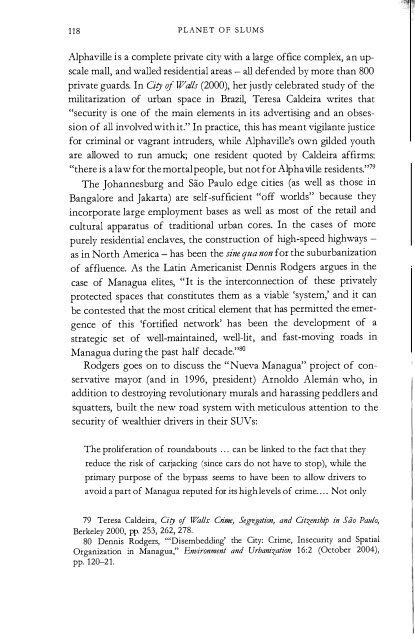Untitled - Rebel Studies Library
Untitled - Rebel Studies Library
Untitled - Rebel Studies Library
Create successful ePaper yourself
Turn your PDF publications into a flip-book with our unique Google optimized e-Paper software.
118<br />
PLANET OF SLUMS<br />
Alphaville is a complete private city with a large office complex, an up<br />
scale mall, and walled residential areas - all defended by more than 800<br />
private guards. In City f Walls (2000), her justly celebrated study of the<br />
militarization of urban space in Brazil, Teresa Caldeira writes that<br />
"security is one of the main elements in its advertising and an obsession<br />
of all involved with it." In practice, this has meant vigilante justice<br />
for criminal or vagrant intruders, while Alphaville's own gilded youth<br />
are allowed to run amuck; one resident quoted by Caldeira affirms:<br />
"there is a law for the mortal people, but not for Alphaville residents."79<br />
The Johannesburg and Sao Paulo edge cities (as well as those in<br />
Bangalore and Jakarta) are self-sufficient "off worlds" because they<br />
incorporate large employment bases as well as most of the retail and<br />
cultural apparatus of traditional urban cores. In the cases of more<br />
purely residential enclaves, the construction of high-speed highways -<br />
as in North America - has been the sine qua non for the suburbanization<br />
of affluence. As the Latin Americanist Dennis Rodgers argues in the<br />
case of Managua elites, "It is the interconnection of these privately<br />
protected spaces that constitutes them as a viable 'system,' and it can<br />
be contested that the most critical element that has permitted the emer<br />
gence of this 'fortified network' has been the development of a<br />
strategic set of well-maintained, well-lit, and fast-moving roads in<br />
Managua during the past half decade."so<br />
Rodgers goes on to discuss the "Nueva Managua" project of conservative<br />
mayor (and in 1996, president) Arnoldo Aleman who, in<br />
addition to destroying revolutionary murals and harassing peddlers and<br />
squatters, built the new road system with meticulous attention to the<br />
security of wealthier drivers in their SUV s:<br />
The proliferation of roundabouts ... can be linked to the fact that they<br />
reduce the risk of carjacking (since cars do not have to stop), while the<br />
primary purpose of the bypass seems to have been to allow drivers to<br />
avoid a part of Managua reputed for its high levels of crime .... Not only<br />
79 Teresa Caldeira, City ( Walls: Crime, Segregation, and Citzenship in Sao Paulo,<br />
Berkeley 2000, pp. 253, 262, 278.<br />
. '<br />
80 Dennis Rodgers, "'Disembeddillg' the City: Crime, Insecunty and Spatlal<br />
Organization in Managua," Environment and Urbanization 16:2 (October 2004),<br />
pp. 120-21.<br />
HAUSSMANN IN THE TROPICS<br />
do the road works seem predominantly to connect locations associated<br />
with the lives of the urban elites, but there has been simultaneously an<br />
almost complete neglect of roads in parts of the city that are unequivo<br />
cally not associated with the urban elites [read: pro-SandinistaJ.81<br />
In a similar fashion, privately built motorways in Buenos Aires now<br />
allow the rich to live full time in their "countries" (country club homes)<br />
in distant Pilar and commute to their offices in the core. (Gran Buenos<br />
Aires also has an ambitious edge city or megaempredimiento, called<br />
Nordelta, whose financial viability is uncertain.)82 In Lagos, likewise, a<br />
vast corridor was cleared through densely populated slums to create an<br />
expressway for the managers and state officials who live in the wealthy<br />
suburb of Ajah. Examples of such networks are numerous, and<br />
Rodgers emphasizes that the "ripping out [ofj large swaths of the<br />
metropolis for the sole use of the urban elites ... encroaches on the<br />
public space of the city in a much more extensive way than fortified<br />
enclaves do."83<br />
It is important to grasp that we are dealing here with a fundamental<br />
reorganization of metropolitan space, involving a drastic diminution of<br />
the intersections between the lives of the rich and the poor, which transcends<br />
traditional social segregation and urban fragmentation. Some<br />
Brazilian writers have recently talked about "the return to the medieval<br />
city," but the implications of middle-class secession from public space<br />
- as well as from any vestige of a shared civic life with the poor - are<br />
more radica1.84 Rodgers, following Anthony Giddens, conceptualizes<br />
the core process as a "disembedding" of elite activities from local territorial<br />
contexts, a quasi-utopian attempt to disengage from a<br />
suffocating matrix of poverty and social violence.8s Laura Ruggeri (discussing<br />
Hong Kong's Palm Springs) stresses as well the contemporary<br />
81 Ibid.<br />
82 Guy Thuillier, "Gated Communities in the Metropolitan Area of Buenos<br />
Aires," pp. 258-59.<br />
83 Rodgers, "'Dis embedding' the City," p. 123.<br />
84 Amalia Geraiges de Lemos, Francisco Scarlato, and Reinaldo Machado, "0<br />
Retorno a Cidade Medieval: 0 s Condominios Fechados da Metropole Paulistana," in<br />
Luis Felipe Cabrales Barajas (ed.), Latinoamfrica: Paises Abierlos, Ciudades Cerradas,<br />
Guadalajara 2000, pp. 217-36.<br />
85 Rodgers, "'Dis embedding' the City," p. 123.<br />
119


